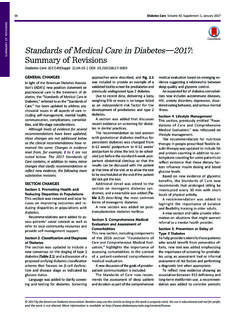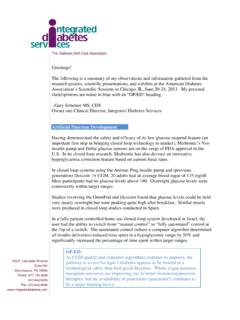Transcription of G ARTICLE IN PRESS - University at Buffalo
1 Please cite this ARTICLE in PRESS as: K. Lunze, et al., Blood glucose control algorithms for type 1 diabetic patients: A methodological review, Process. Control (2012), IN PRESSG ModelBSPC-347; No. of Pages 13 Biomedical Signal Processing and Control xxx (2012) xxx xxxContents lists available at SciVerse ScienceDirectBiomedical Signal Processing and Controljourna l h omepage: glucose control algorithms for type 1 diabetic patients:A methodological reviewKatrin Lunzea, , Tarunraj Singhb, Marian Waltera, Mathias D. Brendelc,d, Steffen LeonhardtaaDepartment of Electrical Engineering, RWTH Aachen University , Aachen 52074, GermanybDepartment of Mechanical and Aerospace Engineering, University at Buffalo , Buffalo , NY 14260, USAcUniversity Hospital Dresden, Endowed Professorship for Regenerative Therapies in Diabetes Mellitus at the Technical University Dresden, GermanydGerman Center for Diabetes Research, Carl-Gustav-Carus University Hospital, 3.
2 Medical Department and Policlinic, Dresden 01309, Germanya r t i c l e i n f oArticle history:Received 22 August 2011 Received in revised form17 September 2012 Accepted 17 September 2012 Available online xxxKeywords:Artificial pancreasBlood glucose controlModel predictive controlPatient modelInsulin therapy devicesa b s t r a c tA method for optimal continuous insulin therapy for diabetes patients has been sought since the early1970s. Although technical and medical advances have been made, a fully automated artificial pancreasto replace the functions of the natural organ is still a research aim. This review compares recent con-trol algorithms for type 1 diabetic patients which automatically connect continuous glucose monitoringand insulin injection, without patient intervention.
3 Black-box model and gray-box model based controlstrategies are described and their performances are evaluated, with a focus on their feasibility of imple-mentation in a real-life situation. In conclusion, a satisfactory control strategy has not yet been proposed,mainly because most control algorithms rely on continuous blood glucose measurement which is notyet available. Modeling the effect of glucose ingestion as an external disturbance on the time evolutionof blood glucose concentration, is now the norm for the control community. In contrast, the effects ofphysical activity on the metabolic system is not yet fully understood and remain an open issue.
4 Moreover,clinical studies on evaluation of control performance are scarce. Therefore, research on blood glucose con-trol needs to concentrate on advanced patient modeling, control optimization and control performanceevaluation under realistic patient-oriented conditions. 2012 Elsevier Ltd. All rights Introduction ..002. Artificial pancreas .. State-of-the-art .. Challenges of control design .. Requirements .. Performance evaluation ..003. Diabetes patients .. Characteristics .. Mathematical models ..004. Black-box model-based control algorithms .. Control idea .. Control strategies .. PID control with variable control gain .. Switching PID control.
5 Repetitive control strategy ..005. Grey-box model-based control algorithms .. Control idea .. Model-predictive control .. Strategy ..00 Corresponding address: (K. Lunze).1746-8094/$ see front matter 2012 Elsevier Ltd. All rights cite this ARTICLE in PRESS as: K. Lunze, et al., Blood glucose control algorithms for type 1 diabetic patients: A methodological review, Process. Control (2012), IN PRESSG ModelBSPC-347; No. of Pages 132K. Lunze et al. / Biomedical Signal Processing and Control xxx (2012) xxx Application .. State estimation .. Linear MPC strategies .. LMPC based on linear step-response model .. LMPC based on minimal model.
6 Discrete LMPC based on Dalla Man s model .. Nonlinear MPC strategies .. NMPC with Dalla Man s model .. NMPC adaptive to insulin sensitivity .. Feedforward-feedback control ..006. Control limitations .. Control overview .. Performance evaluation .. Time delays .. Actuating variables .. Disturbances ..007. Conclusion ..00 References ..001. IntroductionDiabetes mellitus is a widespread disease. According to theWorld Health Organisation (WHO), in 2011 approximately 346 mil-lion people suffered from diabetes world-wide. India, China andthe USA rank among the top three countries with the largest num-bers of diabetic patients [1]. For 2030, an increase up to 552 millionpatients is prognosed by the International Diabetes Federation (seeDiabetes Atlas 2011).
7 In the human body, the pancreas is responsible for blood glucosecontrol. By producing and releasing the counteracting hormonesinsulin and glucagon, blood glucose concentration can be decreasedor increased, respectively, and stabilized within the physiologicalrange of 70 120 mellitus is characterized by a dysfunction of the pan-creas, often in combination with reduced insulin sensitivity. Basedon the underlying pathological mechanisms, the disease is classi-fied into three types. Patients suffering from type 1 diabetes areinsulin-dependent because the majority of insulin-producing -cells in the pancreas is destroyed due to an autoimmune with type 2 diabetes are initially independent of exoge-nous insulin administration, but will become insulin-dependentover time.
8 These metabolic disturbances are generally caused byreduced insulin sensitivity of the glucose-consuming cells, or dete-riorated glucose sensing of the pancreas. Initially, this results inincreased insulin production and, finally, in a progressive loss ofinsulin secretion. Other forms of diabetes which are frequently non-permanent are caused by metabolic stress in critically ill patients,drug-induced hypoglycemia or by the moment, insulin-dependent diabetic patients face thedaily challenge of manually controlling their blood glucose con-centration as shown in Fig. 1. After measuring their blood glucoseconcentration with a test strip, they have to determine theFig.
9 1. Schematic of current glucose management process: the patient appears onceas the metabolic system to be controlled and again as the controller size of the insulin bolus and inject it subcutaneouslywith an insulin pen or pump. Thus, in the resulting discrete con-trol loop, the patient appears twice: once as the glucose metabolicsystem which has to be controlled and again as the controlleritself (cognitive system). In the decision-making process, externaldisturbances and internal system changes have to be taken intoaccount. Since it is difficult to take all effects into consideration,the discrete control method is often accompanied by hypo- orhyperglycemic events.
10 On the one hand, a low blood glucose con-centration (<60 mg/dl) may induce an acute medical condition,such as sudden loss of consciousness or even coma, which canbe fatal. On the other hand, a high blood glucose concentration(>180 mg/dl) may not be immediately life-threatening but can leadto severe secondary disorders, such as diabetic nephropathy, neu-ropathy and avoid patients having to determine each insulin dose manu-ally, and to limit the large variation in blood glucose concentration,an artificial pancreas needs to be developed as an important scien-tific research aim. The basic idea is to calculate the required insulindose using a control algorithm based on continuous glucose mea-surements, which are obtained via a sensor without human this, a mathematical patient model may support the compu-tation of an appropriate insulin injection.





